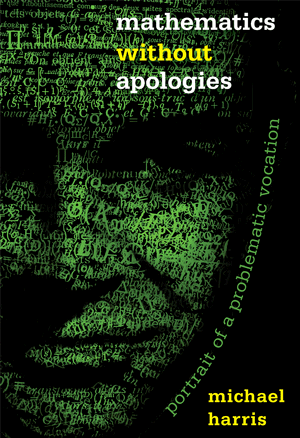“It’s not the marbles that matter. It’s the game.” Dutch proverb
“In mathematics, the art of proposing a question must be held of higher value than solving it.” Cantor
Mathematics can be made simple, even obvious; and beautiful, and even useful. Just read my previous post about Ian Stewart’s 17 Equations That Changed the World. But there are other more provocative views. You just need to read Michael Harris’ mathematics without apologies.
Harris is certainly not as easy to read as Stewart. But it is as (maybe more) enriching. His Chapter 3 for example is entitled Not Merely Good, True and Beautiful. In this world of increasing pressure to justify the usefulness of science, the author fights back. “There is now a massive literature on the pressures facing university laboratories. These books mostly ignore mathematics, where stakes are not so high and opportunities for commercial applications are scarce, especially in the pure mathematics.” [Page 55]
But even Truth seems to be at stake.“If one really thinks deeply about the possbility that the foundations of mathematics are inconsistent, this is extremely unsettling for any rational mind” [Voevodsky quoted on page 58] and a few lines before “Bombieri recalled the concerns about the consistency, reliability, and truthfulness of mathematics that surfaced during the Foundations Crisis and alluded to the ambiguous status of computer proofs and too-long proofs.”
Finally Harris mentions some confusion about Beauty quoting Villani: “The artistic aspect of our discipline is [so] evident” that we don’t see how anyone could miss it.. immediatley adding that “what generally makes a mathematician progress is the desire to produce something beautiful.” Harris then quotes an art expert advising museum-goers to “let go of [their] preconceived notions that art has to be beautiful”. [Page 63]
Harris adds that “the utility of practical applications, the guarantee of absolute certainty and the vision of mathematics as an art form – the good, the true and the beautiful, for short – have the advantage of being ready to hand with convenient associations, though we should keep in mind that what you are willing to see as good depends on your perspective, and on the other hand the true and beautiful can themselves be understood as goods.” [Pages 63-4]
The short answer to the “why” question is going to be that mathematicains engage in mathematics because it gives us pleasure. [Page 68]
Maybe more in another post…
Instead of another post, here is a short section extracted from page 76 and added on August 27:
The parallels between mathematics and art
“Here the presumed but largely unsubstantiated parallel between mathematics and the arts offers unexpected clarity. Anyone who wants to include mathematics among the arts has to accept the ambiguity that comes with that status and with the different perspectives implicit in different ways of talking about art. Six of these perspectives are particularly relevant: the changing semantic fields the word art has historically designated; the attempts by philosophers to define art, for example, by subordinating it to the (largely outdated) notion of beauty or to ground ethics in aesthetics, as in G. E. Moore’s Principia Ethica, which by way of Hardy’s Apology continues to influence mathematicians; the skeptical attitude of those, like Pierre Bourdieu, who read artistic taste as a stand-in for social distinction ; the institutions of the art world, whose representatives reflect upon themselves in Muntadas’s interviews ; the artists personal creative experience within the framework of the artistic tradition ; and the irreducible and (usually) material existence of the art works themselves.
Conveniently, each of these six approaches to art as a mathematical counterpart: the cognates of the word mathematics itself, derived form the Greek mathesis, which just means “learning”, and whose meaning has expanded and contracted repeatedly over the millennia and from one culture to another, including those that had no special affinity for the Greek root; the Mathematics of philosophers of “encyclopedist” schools; school mathematics in its role as social and vocational filter; the social institutions of mathematics with their internal complexity and heir no-less-complex interactions with other social and political institutions; the mathematicians personal creative experience within the framework of the tradition (the endless dialogue with the Giants and Supergiants of the IBM and similar rosters); and the irreducible and (usually) immaterial existence of theorems, definitions and other mathematical notions.”
Maybe more in another post…

